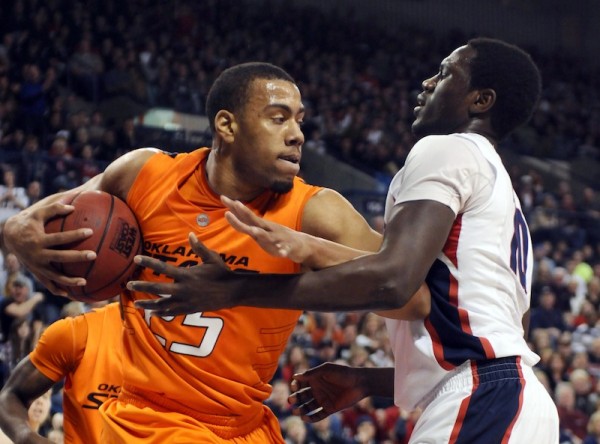The Darrell Williams Assault Case: A Feel-Good Story Gone Wrong
Posted by Chris Johnson on October 19th, 2012Chris Johnson is an RTC Columnist. He can be reached @ChrisDJohnsonn.
The latest development in the Darrell Williams sexual assault case snuck under the national college hoops news radar Thursday afternoon, with word breaking that Williams filed a notice to appeal his recent sentence and conviction. In a long legal battle with numerous twists, turns and hot-button issues, including accusations of racial bias and prejudiced legislative procedures, Williams’ most recent defensive measure is only the tip of the iceberg. The story goes back to December 2010, when Williams, a member of the Oklahoma State men’s basketball team, was accused of fondling and making unsolicited sexual advances on two women at a house party. He was later convicted on two counts of rape and remained in jail until receiving a suspended sentence last week. The incident reportedly took place in the basement, but Williams claimed he has no recollection of any interactions in the specified room. He went on to question the merits of the allegations, and raised the possibility that he had been misidentified among several others at the party wearing OSU athletic apparel. The lack of physical evidence and the very real possibility of a false accusation invited skepticism and doubt over the validity of the women’s allegations. But the real rub surrounded the process by which Williams was identified. Immediately following the party, the women wrote an anonymous letter to various media outlets providing a brief description of the assault, but failed to specify an attacker. According to testimony, the women – one of whom already knew Williams from seeing him play – pointed Williams out three days after the alleged crime when Stillwater police showed them a photo of the entire OSU basketball team.

After receiving a suspended sentence, Williams remains in courtroom limbo as he prepares to file an appeal (Photo credit: US Presswire).
That pretty much wrapped things up. Williams was locked up on questionable testimony, with little in the way of actual hard evidence, and a tenuous if vague account of what actually happened. That was all the prosecution needed. The possibility remains that Williams will win his appeal and clear his name, but clinging to hopes that a typically rigid legal system will provide vindication is a foreboding proposition. Williams has maintained his innocence throughout the process, but barring a successful ruling on his requisition, he will have to register as a sex offender. A coalition of fans and media members have rallied around Williams’ cause, springing a Facebook group and donning “Free Darrell 25” (a reference to his number at OSU) t-shirts at Friday’s hearing. This would not be the first time the legal process committed an egregious misstep. False accusations — whether through error or vendetta — happen all the time, and there are plenty more that are never brought to light. It is difficult to say whether miscalculated courtroom procedure is at work here, or if Williams was simply caught in the wrong place at the wrong time. When you pack 80 people into a house party, with many large athletes crammed into the same suffocated space, parsing the truth from the specious – particularly if alcohol is involved, which is a reasonable assumption at collegiate social gatherings like this – is never easy.
The racial component adds another layer of skepticism. Allegations of prejudicial confirmation bias have surfaced, and that’s completely understandable. With so little evidence, and a history of bigoted and slanted legal outcomes in this country (though that’s been gradually phased out over the past half century), when you connect the dots, dig into the facts and realize the pieces just don’t seem to add up, it’s only natural to question the possibility of other factors potentially influencing this process. To top it all off, the jury, drawn from mostly white Payne County, Oklahoma, was composed of 11 white members and one of Asian descent. Let me be clear: I am not making accusations of biased judicial proceedings. I’m simply laying out the facts, and offering a complete contextual picture to give you a window into the factual basis from which those complaints are derived.
Wherever you fall on this case, whether you’re behind Williams or in favor of the legal actions taken against him, you can’t help but sympathize with a guy who’s endured so much just to get to this point in the first place. Raised by a single mother, Williams resisted the vagaries of Chicago’s perilous urban culture while helping guide and care for his four siblings. He used basketball as an avenue to a better lifestyle, with the goal of attaining the free college education unavailable to the majority of kids native to his hazardous birthplace. He perservered through those humble beginnings, landed at Chipola Junior College in Florida, and kept up his grades and basketball prowess to draw the interest of several Division I programs. Once he reached OSU, Williams emerged as a vital cog in the Cowboys’ lineup. In the final two games before being suspended from the team in February 2011, Williams notched consecutive double-doubles and led the team in rebounding at that point in the season.
His ascendance, from the very depths of social and familial problems to a promising college and potential NBA future, has been halted in an abrupt and potentially unforgiving way. The feel-good story finds itself at a cross-roads. Williams overcame a harsh upbringing, eschewing the wrongful path and various injustices that loom so large in those parts and leveraging his skills on the hardwood to reach his childhood dream. To have that taken away at this stage – whether on legitimate claims or due to an unfortunate decision or some combination therein – would count as a huge shame. There’s no other way around it, really; it’s just sad.












































